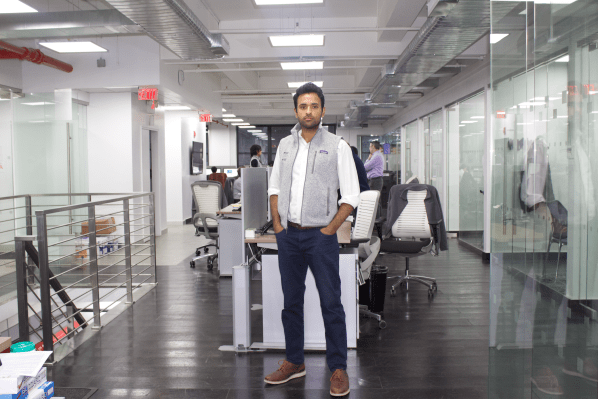When it comes to millennials and healthcare companies, recent history gives plenty of reason for pause. Elizabeth Holmes, the founder and CEO of Theranos, has watched her star fall precipitously over the last year, amid a continuing drumbeat of allegations that her blood testing company never worked as advertised. Meanwhile, Martin Shkreli, a young hedge fund manager turned pharmaceutical executive, was for a while the country’s most reviled businessperson, after his relatively small company, Turing Pharmaceuticals, bought a drug that treats toxoplasmosis and promptly raised its price from less than $20 per tablet to $750.
If these black marks on the industry are slowing down 31-year-old Vivek Ramaswamy in any way, you wouldn’t know it. He thinks his company, Roivant, will one day be a giant holding company for dozens of independent biopharmaceutical companies — both by developing drugs as well as focusing squarely on reducing the time and cost of the drug development process.
It all sounds rather lofty. Then again, it’s hard to argue why Ramaswamy shouldn’t be one to reshape how drugs are brought to market.
A Cincinnati native who studied biology at Harvard then earned a law degree from Yale, it was when Ramaswamy began working as an analyst in 2007 at the hedge fund QVT Financial in New York that he first observed the problem that defines his work today. He noticed that many big and small pharmaceutical firms abandon promising drugs for various reasons having nothing to do with their efficacy. Sometimes, it’s a strategic decision to focus elsewhere; sometimes, it owes to a lack of resources. Seeing an opportunity to complete the development of some of these abandoned late-stage drug candidates and get them to market quickly, Ramaswamy struck out on his own in 2014.
Having earned the trust of QVT was key. The firm, along with Dexcel Pharma, an Israeli firm that reviewed Ramaswamy’s work at QVT, provided Ramaswamy’s new holding company with just less than $100 million in capital — a feat, given that he was just 28 years old at the time.
Yet what Ramaswamy has done with Roivant in the years since is pretty remarkable, too.
While Silicon Valley has obsessed over Theranos, Ramaswamy has acquired a dozen drugs, including an Alzheimer’s pill that’s now named intepirdine. He also formed a company around that drug, Axovant Sciences, and took it public in 2015 — despite that the drug’s Phase 3 results won’t be out until this year.
It was the biggest biotech IPO ever in the U.S., raising $360 million. It has largely held up, too. Axovant’s shares, which opened at $15, currently trade around $13.25.
Roivant has also launched Enzyvant Sciences, a company focused on rare genetic pediatric conditions that Ramaswamy calls “ignored and underserved,” including a metabolic disorder called Farber disease and DiGeorge syndrome, a genetic disease that results in poor development of several body systems.
It has also teamed up with one of Japan’s oldest companies, Takeda Pharmaceuticals, to start Myovant Sciences, a standalone company that’s focused on women’s health issues. The drug candidate around which the company is centered is called Relugolix, which aims to treat endometriosis and uterine fibroids.
Takeda is currently conducting two Phase 3 studies in women with uterine fibroids in Japan. In the meantime, Myovant last year orchestrated what was — again — the biggest biotech IPO of the year.

How is Roivant doing so much at once? Its financing approach plays a major role. The Alzheimer’s pill that Axovant is currently researching was bought from GlaxoSmithKline as it was dialing down its neuroscience research. Roivant paid a mere $5 million in upfront payments, with the promise of significant upside if the drug works. (Specifically, Axovant will pay Glaxo $160 million in milestones and a 12.5 percent royalty on sales.)
Roivant has also now raised more than $1 billion from investors since its inception. Ramaswamy declines to break out from where that money has come, but he calls a recent, undisclosed amount of funding from hedge fund Viking Global Investors “one of the largest, if not the largest, private financing of a biotech company in history.”
Roivant is meanwhile counting on the power of equity to attract top talent, which seems to be working thus far. Among the 150 employees across Roivant’s organization is Lynn Seely, who is leading Myovant as its CEO. Seely is an endocrinologist with more than 20 years of drug development experience, including as chief medical officer of biotech firm Medivation, where she worked for 10 years ending in 2015. (Medivation sold last year to Pfizer for $14 billion.)
An even newer hire is Alvin Shih, who recently joined as the CEO of Enzyvant. Shih was previously head of R&D at the publicly traded biopharma company Retrophin (where Shkreli was once CEO). He was also the COO of a rare disease research unit at Pfizer.
The idea, explains Ramaswamy, is to create individual companies around each drug or small groupings of candidates that Roivant acquires, then install the scientists who developed the drugs and provide them with big rewards if the drugs prove useful. If the drugs don’t pan out, Roivant will find another place for the scientists — potentially at another company under its umbrella.
Whether the scheme will work longer term isn’t clear, but it’s easy to appreciate why people like Seely and Shih were drawn to Ramaswamy’s vision. At traditional, top-down pharmaceutical companies, scientists aren’t typically rewarded when a drug they’ve developed becomes a blockbuster, and failed drugs often translate into job cuts.
“It sounds vanilla, but I can’t overstate the importance of re-aligning R&D personnel,” says Ramaswamy of his decentralized approach. “A lot of what you see in conventional pharma R&D is, because [scientists’] jobs are on the line if their projects fail, in many instances, clinical studies aren’t designed to get the answer but instead not get the answer. There’s a kick-the-can mentality.” By addressing that incentive misalignment, he insists, “we’ve stacked the odds in our favor.”

Naturally, questions remain, including whether there’s been a biotech bubble in recent years.
When Axovant went public, a columnist at FierceBiotech warned that it should “scare the hell” out of investors, writing, “The fact that someone can make something of this size out of virtually nothing should be of concern to everyone in the industry. Magical thinking will take you just so far (remember the intoxicating dot-com days?).”
It’s young, yes, but Roivant doesn’t have a sure-fire winner on its hands, either. Though Ramaswamy argues that the “rationale [for Axovant’s Alzheimer’s drug] is uniquely strong relative to other therapies that have entered into Phase 3 trials,” he also concedes that he “can’t promise the clinical trials will work.”
Still he and his investors are willing to bet that at the pace the company is moving, some subset of the drug candidates it’s exploring will pay off — even if it’s by discovering new ways to apply the underlying science that it’s acquiring.
If it doesn’t, expect the Holmes and Shkreli comparisons to follow.
Not that Ramaswamy sounds terribly concerned about that happening. “The more general skepticism about another millennial that likes to claim they’re disrupting another industry — that doesn’t serve me well,” he says with a laugh. But it’s “irrelevant to our business model,” he continues. In fact, he says, “I’d encourage more young people to apply their talents beyond finance and consulting and to think about reshaping how medicines are brought to market and how the business is run. This is a bigger problem that talent has ignored for a very long time.”
Besides, as he’s quick to point out, while “young ambitious people are flocking to companies like Facebook and Google and Snapchat and Uber,” the trillion or so dollars up for grabs in the pharmaceutical industry “far exceeds the scale of the industries being tackled most by Silicon Valley startups.”
